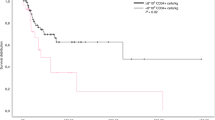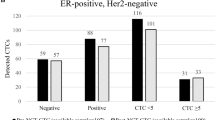Summary:
Breast cancer cells have been detected in autologous blood stem cell collections of early stage breast cancer patients, but their clinical significance is undefined. From October 1993 to August 1998, 32 consecutive Stage II breast cancer patients with 4–9-positive nodes underwent stem cell apheresis. The patients were treated with cyclophosphamide 1.75 gm/m2, etoposide 400 mg/m2 and cisplatin 50 mg/m2 daily for 3 days, followed by infusion of the autologous cells. Cytospins of cells from each apheresis collections and from an aliquot of three pooled collections were examined for cytokeratin expression using an immunocytochemical assay. The cells were considered positive for tumor if at least one cell with tumor morphology stained positively for cytokeratin. Negative aliquots were confirmed with RT-PCR. Six patients (19%) had positive collections. In total, 24 patients (75%) were disease free a median of 61 (30–86) months after transplant. Eight patients relapsed at a median of 17 (8–27) months after transplant. Four of the disease-free patients and two of the relapsed patients had positive apheresis collections. There was no significant correlation between the presence of detectable tumor cells in the graft product and outcome.
This is a preview of subscription content, access via your institution
Access options
Subscribe to this journal
Receive 12 print issues and online access
$259.00 per year
only $21.58 per issue
Buy this article
- Purchase on Springer Link
- Instant access to full article PDF
Prices may be subject to local taxes which are calculated during checkout
Similar content being viewed by others
References
Nemoto T, Vana J, Bedwani R et al. Management and survival of female breast cancer; results of a national survey by the American College of Surgeons. Cancer 1980; 45: 2917–2924.
Schumacher M, Bastert G, Bojar H et al. Randomized 2 × 2 trial evaluating hormonal treatment and the duration of chemotherapy in node-positive breast cancer patients. J Clin Oncol 1994; 12: 2086–2093.
Peters W, Rosner G, Vredenburgh J et al. A prospective, randomized comparison of two doses of combination alkylating agents as consolidation after CAF in high-risk primary breast cancer involving ten or more axillary lymph nodes: preliminary results of CALGB 9082/SWOG 9114/NCIC MA-13. Proc ASCO 1999; 18: 1a (abstr 2).
Diel IJ, Kaufmann M, Costa SD et al. Micrometastatic breast cancer cells in bone marrow at primary surgery: prognostic value in comparison with nodal status. J Natl Cancer Inst 1996; 88: 1652–1658.
Braun S, Cevatli BS, Assemi C et al. Comparative analysis of micrometastasis to the bone marrow and lymph nodes of node-negative breast cancer patients receiving no adjuvant therapy. J Clin Oncol 2001; 19: 1468–1475.
Vredenburgh JJ, Silva O, Broadwater G et al. The significance of tumor contamination in the bone marrow from high-risk primary breast cancer patients treated with high-dose chemo-therapy and hematopoietic support. Biol Blood Marrow Transplant 1997; 3: 91–97.
Sharp JG, Vaughan WP, Kessinger A et al. Significance of detection of tumor cells in hematopoietic stem cell harvests of patients with breast cancer. In: Dicke KA, Armitage JO, Dicke-Evenger MJ (eds). Autologous Bone Marrow Transplantation Proceedings of the Fifth International Symposium. The University of Nebraska Medical Center: Omaha, 1991, pp 385–391.
Solano C, Badia B, Lluch A et al. Prognostic significance of the immunocytochemical detection of contaminating tumor cells (CTC) in apheresis products of patients with high-risk breast cancer treated with high-dose chemotherapy and stem cell transplantation. Bone Marrow Transplant 2001; 27: 287–293.
Stadtmauer EA, Tsai DE, Sickles CJ et al. Stem cell transplantation for metastatic breast cancer: analysis of tumor contamination. Med Oncol 1999; 16: 279–288.
Kasimir-Bauer S, Mayer S, Bojko P et al. Survival of tumor cells in stem cell preparations and bone marrow of patients with high-risk or metastatic breast cancer after receiving dose-intensive or high-dose chemotherapy. Clin Cancer Res 2001; 7: 1582–1589.
Brugger W, Bross KJ, Glatt M et al. Mobilization of tumor cells and hematopoietic progenitor cells into peripheral blood of patients with solid tumors. Blood 1994; 83: 636–640.
Passos-Coelho JL, Ross AA, Moss TJ et al. Absence of breast cancer cells in a single-day peripheral blood progenitor cell collection after priming with cyclophosphamide and granulocyte-macrophage colony-stimulating factor. Blood 1995; 85: 1138–1143.
Ross AA, Cooper BW, Lazarus HM et al. Detection and viability of tumor cells in peripheral blood stem cell collections from breast cancer patient using immunocytochemical and clonogenic assay techniques. Blood 1993; 82: 2605–2610.
Weaver CH, Moss T, Schwartzberg LS et al. High-dose chemotherapy in patients with breast cancer: evaluation of infusing peripheral blood stem cells containing occult tumor cells. Bone Marrow Transplant 1998; 21: 1117–1124.
Traystman MD, Cochran GT, Hake SJ et al. Comparison of molecular cytokeratin 19 reverse transcriptase polymerase chain reaction (CK19 RT-PCR) and immunocytochemical detection of micrometastatic breast cancer cells in hematopoietic harvests. J Hematother 1997; 6: 551–561.
Datta YH, Adams PT, Drobyski WR et al. Sensitive detection of occult breast cancer by the reverse-transcriptase polymerase chain reaction. J Clin Oncol 1994; 12: 475–482.
Preti RA, Lazarus HM, Winter J et al. Tumor cell depletion of peripheral blood progenitor cells using positive and positive/negative selection in metastatic breast cancer. Cytotherapy 2001; 3: 85–95.
Burgess J, Mills B, Griffith M et al. Breast tumor contamination of PBSC harvests: tumor depletion by positive selection of CD34+ cells. Cytotherapy 2001; 3: 285–294.
Chabannon C, Cornetta K, Lotz JP et al. High-dose chemotherapy followed by reinfusion of selected CD34+ peripheral blood stem cells in patients with poor-prognosis breast cancer: a randomized multicentre study. Br J Haematol 1998; 78: 913–921.
Slade MJ, Smith BM, Sinnett HD et al. Quantitative polymerase chain reaction for the detection of micrometastases in patients with breast cancer. J Clin Oncol 1999; 17: 870–879.
Kruger WH, Kroger N, Togel F et al. Disseminated breast cancer cells prior to and after high-dose therapy. J Hematother Stem Cell Res 2001; 10: 681–689.
Author information
Authors and Affiliations
Rights and permissions
About this article
Cite this article
Reed, E., Kessinger, A., Murphy, B. et al. Occult tumor cells detected in autologous blood stem cell harvests have no impact on 5 year outcomes for breast cancer patients with 4–9 positive nodes treated with adjuvant high-dose therapy and stem cell transplantation. Bone Marrow Transplant 31, 571–574 (2003). https://doi.org/10.1038/sj.bmt.1703878
Received:
Accepted:
Published:
Issue Date:
DOI: https://doi.org/10.1038/sj.bmt.1703878



